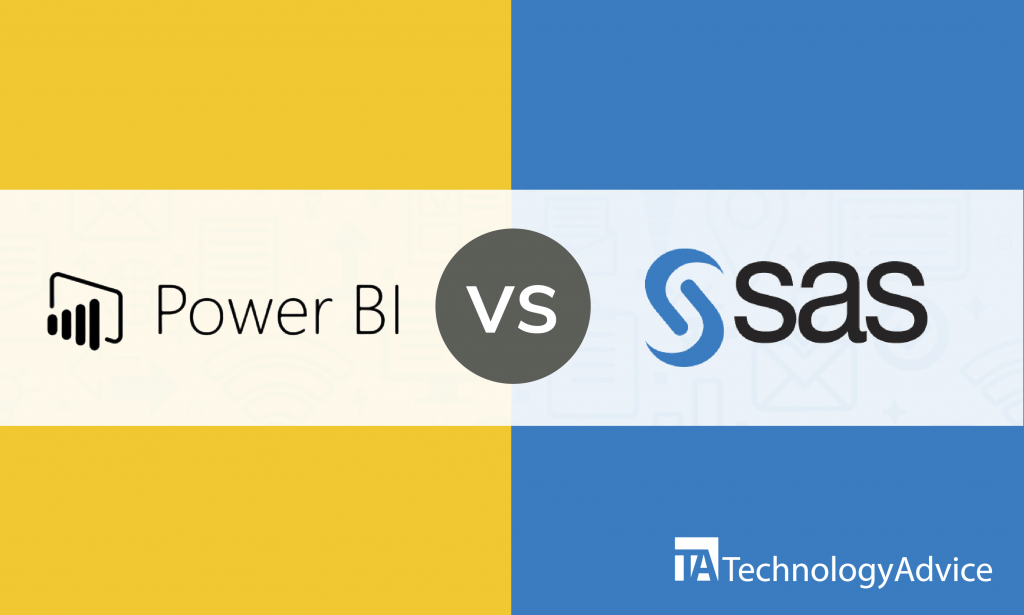- categoryBusiness Intelligence
- ContentComparison
One important task business owners have to help improve business outcomes is to use business intelligence (BI) software. These are tools companies use to retrieve, evaluate, and interpret data into useful business insights. BI processes help businesses better understand customers, steer clear from making business mistakes, and forecast profit growth.
As opposed to competitive intelligence, BI software gets its information from a business’s internal data, not from external sources. Some of these sources are reporting, dashboards, data warehousing, and data visualization. BI has empowered businesses by giving them access to this information to help them make sound and informed business decisions. What used to be quarterly and yearly reports are now done at light-speed, thanks to BI software.
We’ll compare two popular BI software products: Power BI vs. SAS BI. We’ll consider their features, integrations, and prices to help you make a sound choice when it comes to your business’s data analysis. You can use our Product Selection Tool to look at more options. It’s free and offers 5 recommendations from our Technology Advisors that are tailored to your business needs.
Power BI vs. SAS BI: An overview
Power BI, a product of Microsoft, is a web-based suite of applications and connectors that put together data sources to create interactive and coherent insights. It lets businesses connect to their data sources, whether these are on-site or cloud-based hybrid data warehouses or a simple Excel spreadsheet. With Power BI, businesses can easily access data, discover what’s important, and share the information with everyone. The software consists of a Windows desktop application called Power BI Desktop, an online SaaS called Power BI service, and Power BI mobile apps that support all operating systems.
SAS BI is a cloud-based enterprise analysis tool designed for large businesses in monitoring metrics and managing interactive reports. It comes with forecasting functions, marketing reports, customizable dashboard, ad-hoc analysis, and data source connectors. SAS BI uses compelling visuals to help users grasp the information from data, which is explained in simplest terms. Users can build graphs and reports and increase productivity across processes.
Power BI vs. SAS BI: A comparison of features
Power BI is a user-friendly application and has the following features:
- One of the largest and fastest-growing clouds: Power BI lets users create and share interactive data visualizations throughout the world through its global data centers. There are national clouds in place to meet regulation and compliance needs.
- Accelerated data prep with Azure: Azure Data Lake within Power BI lets users simplify the way they analyze and share huge quantities of data. This is helpful to data engineers and analysts as it saves time when collaborating and analyzing insights.
- Unified self-service and enterprise analytics: Power BI provides a single platform for business data and self-service analytic needs. Users can use the software’s fixed layout paginated reports, open connectivity framework, application lifecycle management toolkit, and semantic models.
- Industry-leading AI: The software has AI that helps non-data scientists prepare data, gain insight from both structured and unstructured data, and build machine learning models.
- Excel integration: Sharing business data is possible with Power BI since it integrates with Excel to analyze and publish data.
SAS BI has its own set of features:
- Smart visualizations: Users can present data and results in the most compelling way through SAS BI’s advanced data visualization techniques and guided analysis.
- Text analysis: SAS BI provides insights from text and social media data for both positive and negative sentiments.
- Location analytics: Analysis in geographical context can be done with SAS BI by combining location data with traditional data sources.
- Self-service data: SAS BI lets users import data, apply basic data quality functions, and join tables with its drag-and-drop capabilities.
Power BI vs. SAS BI: A comparison of prices
Power BI has three pricing models: Power BI, Power BI Pro, and Power BI Premium. Power BI Pro has a free trial for interested parties, while Premium provides consultations. You may contact the vendor for additional pricing information.
SAS BI does not publicly provide pricing information, which is a common practice of vendors. This allows them to determine the right price for the specific requirements of every business. SAS BI provides a free trial for those who want to test the software.
Power BI vs. SAS BI: A comparison of integrations
Power BI easily integrates with numerous applications and software such as Zendesk, Excel, Azure, QuickBooks Online, Salesforce, Facebook, Twilio, Google Analytics, and Github.
Read also: 4 Sales Gamification Ideas to Improve Performance
SAS’s integration technologies have standards-based communication mechanisms. It integrates easily with Microsoft Outlook and Microsoft Excel.
Improve your business with a competitive BI
Using competitive BI software is imperative. Make your choice by considering a product that is easy to use and simplifies the way data is gathered and interpreted. The ideal BI software should also let users have access to BI information shared by other businesses.
If you want more BI software options, use our Product Selection Tool. It’s fast, free, and takes less than five minutes.
